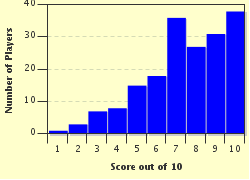Quiz Answer Key and Fun Facts
1. Thomas Hardy is famous for setting his novels in Wessex, where the towns and countryside of south-west England are represented under fictional names. In which of his novels does a stonemason aim to become a student at Christminster, Hardy's fictional name for the university city of Oxford?
2. The city of Bath, a World Heritage Site, was home to the novelist Jane Austen from 1801 to 1806 and two of her novels are partially set in the city. Which of Jane Austen's heroines met her future husband while staying in Bath with her rich friends, Mr and Mrs Allen?
3. Although never directly identified in the novel, the backdrop of Daphne Du Maurier's 'Rebecca' appears to be based on the Cornish countryside and coastline where the author lived for many years. The main location is the estate owned by Maxim de Winter, the husband of the title character. What is the name of this famous fictional house, first introduced in the opening line of the novel: "Last night I dreamt I went to _________ again"?
4. The majority of Sir Arthur Conan Doyle's stories about his great detective Sherlock Holmes are set in and around London. However, which novel is set on Dartmoor in south-west England and concerns an investigation into the mysterious death of a rich landowner, a centuries-old family curse, and an escaped convict?
5. 'The Miller's Tale', 'The Knight's Tale' and 'The Wife of Bath's Tale' are some of the stories included in a 14th century work by Geoffrey Chaucer. The collection describes a story-telling contest that took place during a pilgrimage from Southwark, London to a cathedral in which English city?
6. Charles Dickens' novels are notable for their portrayal of the social issues which blighted Victorian London. One novel particularly highlighted the poverty, unhealthy living conditions and exploitation faced by poor children in this era. What is the name of this well-known work in which the eponymous hero utters the famous line "Please, sir, I want some more"?
7. Which novel by George Eliot, featuring the character Dorothea Brooke, was set in a fictional Midlands town and subtitled 'A Study of Provincial Life'?
8. The novel 'North and South' is set during the period of the industrial revolution in England and depicts the contrast between rural life in the south of England and the harsh conditions experienced by the working classes in the industrial cities of the north. Which author, the friend and biographer of Charlotte Bronte, wrote 'North and South'?
9. Although most commonly associated with Transylvania in central Europe, a large part of Bram Stoker's 'Dracula' is set in England. At which Yorkshire seaside town and port did Count Dracula arrive in England, apparently leaping ashore after his ship ran aground during a storm?
10. 'Wuthering Heights', the only novel written by Emily Bronte, takes place in the dramatic countryside of the Yorkshire moors. It follows the entangled relationships between Catherine Earnshaw and Heathcliff, who live at the remote farmhouse named Wuthering Heights, and siblings Edgar and Isabella Linton from which neighbouring property?
Source: Author
Fifiona81
This quiz was reviewed by FunTrivia editor
MotherGoose before going online.
Any errors found in FunTrivia content are routinely corrected through our feedback system.

